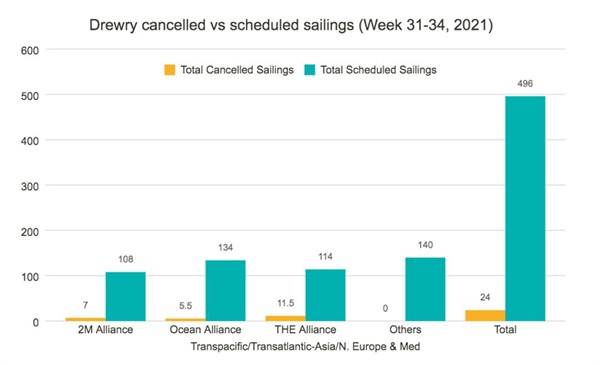With the rising demand before the holiday and the early arrival of the peak season, European and American ports will usher in a surge in Asian imports, which will aggravate the congestion of seaports and inland hubs.
Taking the first half of 2021 as an example, the number of 20-foot containers sent from Asia to the United States reached 10.037 million, an increase of 40% year-on-year, setting a record for nearly 17 years.
With the surge in transportation demand, congestion in major ports around the world has become more severe, and ship delays have further intensified.

According to statistics from the container transportation platform Seaexplorer, as of August 2, 120 ports around the world have reported congestion, and 360 ships are waiting to berth in ports around the world.
The latest data from the signal platform of the Port of Los Angeles, there are currently 16 container ships berthing at the anchorage in Southern California and 12 ships waiting outside the port. The average waiting time for berth has increased from 4.8 days on July 30 to the present. 5.4 days.

In addition, according to the latest report by De Luli, of the 496 voyages on major routes such as trans-Pacific, trans-Atlantic, Asia to Northern Europe and the Mediterranean, the number of voyages announced to be cancelled from week 31 to week 34 has reached 24, and the cancellation rate is 5%.

Among them, THE Alliance announced the cancellation of 11.5 voyages, the 2M Alliance announced the cancellation of 7 voyages, and the Ocean Alliance announced the cancellation of 5.5 voyages.
De Luli also said that the arrival of the peak transportation season has put further pressure on the overwhelmed supply chain.
In view of the current situation of port congestion, industry insiders have analyzed that the container ship capacity backlogged in the port has increased by 600,000 TEU compared with 4 years ago, accounting for about 2.5% of the current global fleet capacity, which is equivalent to 25 large ships. Container Ship.
American freight forwarding company Flexport also said that the transit time from Shanghai to Chicago via the Port of Los Angeles and Long Beach has increased from 35 days to 73 days. This means that it takes about 146 days for a container to depart from the port of origin and return to the port of origin, which is equivalent to a 50% reduction in the available capacity in the market.

As the market’s capacity supply continues to be tight, the port warned: “It is expected that US West Coast ports will suffer a’heavy hit’ throughout August, the on-time rate may further decline, and port operations are in a’stalemate’.”
Gene Seroka, executive director of the Port of Los Angeles, expressed concern that the second half of each year is the peak season for transportation, but the current situation is that due to the large backlog of ships in the early stage, new ships have been concentrated in the port recently, which makes the port face great challenges. And pressure.
Gene Seroka further stated that consumer spending in the United States will continue to remain strong for the rest of 2021, and it is expected that shipping demand growth will be even stronger in the second half of the year.
The American Retail Federation also stated: “In the beginning of the school season, it is expected that most families will continue to buy electronic products, shoes and backpacks and other student supplies, and sales will hit a record high. However, the current shipping efficiency makes us very worried.”
Post time: Aug-14-2021

